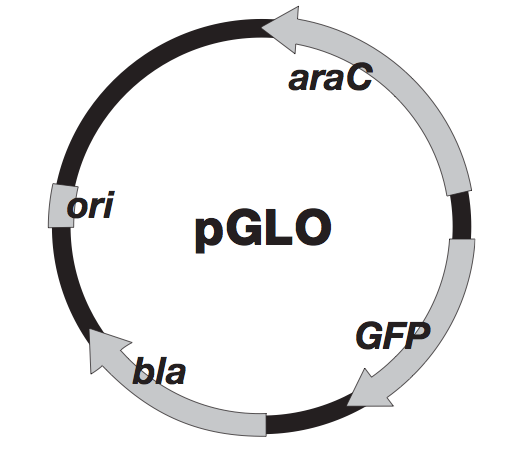What conclusions can you draw about the following results?
-pGLO (LB): No Growth
-pGLO (LB/Amp): No Growth
+pGLO (LB/Amp): No Growth
+pGLO (LB/Amp/Ara): No Growth
Not viable bacteria (Potentially killed during heat shock step)
What is the Transformation Efficiency for Question 6 on Transformation Efficiency Practice?
186 CFUs/ug DNA
What is the purpose of the GFP region on the pGLO plasmid?

Holds the genetic code for making Green Fluorescent Proteins
What is the purpose of the heat shock step?
To open up the cell membrane. Increase permeability to allow the plasmid into the cell.
On which plates would you expect growth if the ampicillin was destroyed from high heat?
All plates
What conclusions can you draw about the following results?
-pGLO (LB): Growth
-pGLO (LB/Amp): No Growth
+pGLO (LB/Amp): No Growth
+pGLO (LB/Amp/Ara): No Growth
Unsuccessful Transformation. Bacteria did not take the plasmid
What is the Transformation Efficiency for Question 4 on Transformation Efficiency Practice?
480 CFUs/ug DNA
What is the purpose of the bla region of the pGLO plasmid?

Holds the code for making Beta-Lactamase, an enzyme that provides resistance to certain antibiotics (ampicillin)
What is a plasmid?
Small, circular segment of DNA that is independent from the genome of bacteria. Usually holds some trait that makes the bacteria more fit to survive
Why does bacteria need to incubate at room temperature after adding LB broth?
(After heat shock step)
To allow the bacteria to recover and begin producing beta-lactamase
What conclusions can you draw about the following results?
-pGLO (LB): Growth
-pGLO (LB/Amp): No Growth
+pGLO (LB/Amp): Growth
+pGLO (LB/Amp/Ara): Growth (Not Glowing)
Arabinose issue (Not added, destroyed with heat, bad stock)
What is the Transformation Efficiency for Question 3 on Transformation Efficiency Practice?
260 CFUs/ug DNA
What is the purpose of the ori region of the pGLO plasmid?

Origin of Replication. Where DNA Polymerase binds when it's time to replicate the plasmid
Which two plates should be directly compared to determine if any genetic transformation has occurred?
-pGLO (LB/Amp) and +pGLO (LB/Amp)
What is the purpose of incubating the bacteria on ice before the experiment?
It slows the fluid moving cell membrane
(Think about putting cold water in a hot glass. It's a similar, yet reversed, process to open up the cell membrane)
What conclusions can you draw about the following results?
-pGLO (LB): Growth
-pGLO (LB/Amp): Growth
+pGLO (LB/Amp): Growth
+pGLO (LB/Amp/Ara): Growth (Glowing)
Bacteria was already ampicillin resistant
What is the Transformation Efficiency for Question 1 on Transformation Efficiency Practice?
190 CFUs/ug DNA
What is the purpose of the araC region of the pGLO plasmid?

Inhibitor Region. Holds the araC regulator protein which controls the production of GFP by blocking the site where RNA Polymerase binds to the plasmid (Moves out of the way when arabinose is present)
What does the transformation solution do in a bacterial transformation experiment?
Coats the DNA (negatively charged phosphate groups) in positively charged Ca2+ ions, allowing plasmids to pass across the negatively charged cell membrane
What causes the araC protein to unbind from its inhibitor region?
Arabinose (Effector/Inducer)
What conclusions can you draw about the following results?
-pGLO (LB): No Growth
-pGLO (LB/Amp): Growth
+pGLO (LB/Amp): Growth (Glowing)
+pGLO (LB/Amp/Ara): Growth (Not Glowing)
Mislabeling
(Bonus: Would the results be valid if transformation has occurred?)
What is the Transformation Efficiency for Question 5 on Transformation Efficiency Practice?
25 CFUs/ug DNA
(Bonus: Are these the expected results of a standard transformation?)
The pGLO plasmid is genetically engineered, recombinant DNA. What was changed from the original plasmid?

araBAD Operon. Held the code for making arabinose digesting enzymes.
(Bonus: Can transformed bacteria digest arabinose?)
Name 3 reasons why E. coli HB101 is a good model organism for bacterial transformations
(Partial answers will receive partial points)
1) Single celled, only 1 cell needs to take up the plasmid
2) Reproduces very quickly, allowing you to see if the new trait has been passed on to new generations
3) Non-harmful bacteria, does not produce toxins
4) Cannot grow independently outside of the lab
What is the purpose of ampicillin in the experiment?
2 reasons:
1) It's an easy way to check and see if the bacteria has transformed
2) It makes it easier to collect the transformed bacteria/Selective Media (You don't have to hunt through a lawn of un-transformed bacteria to find your transformed ones)